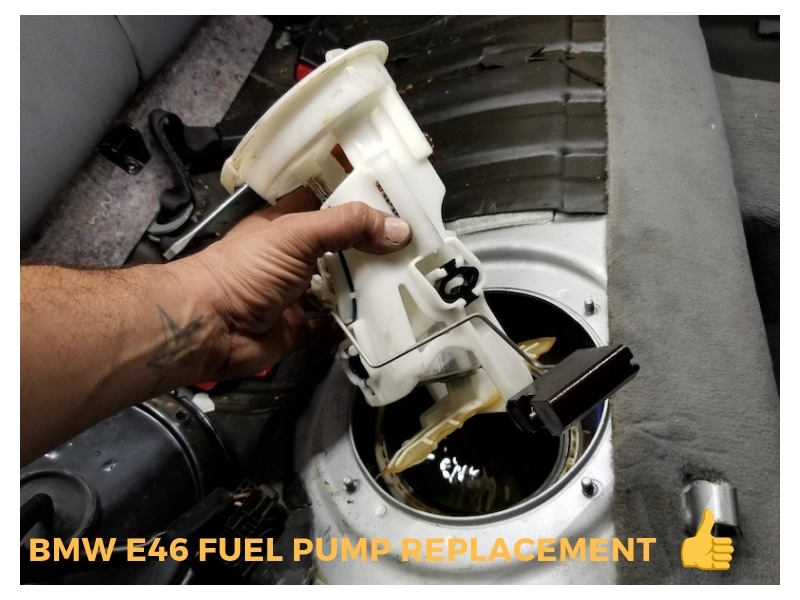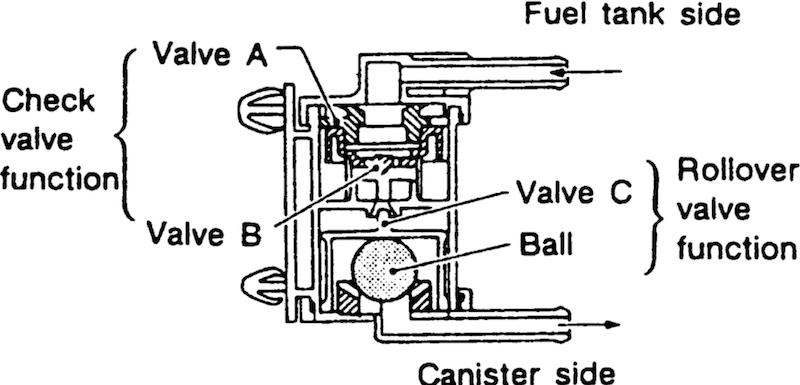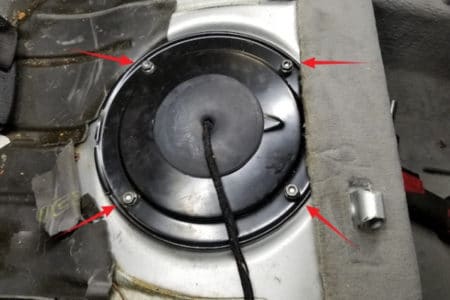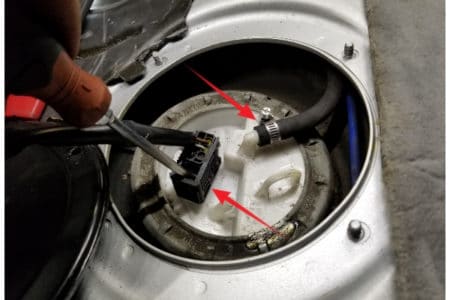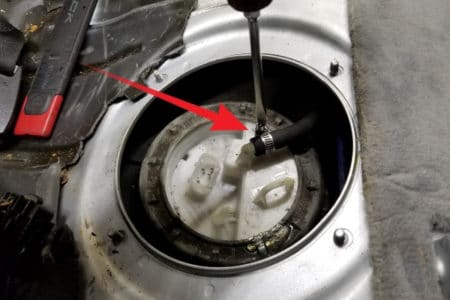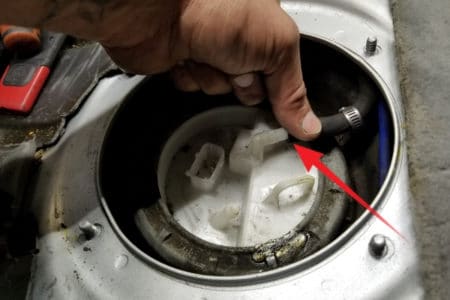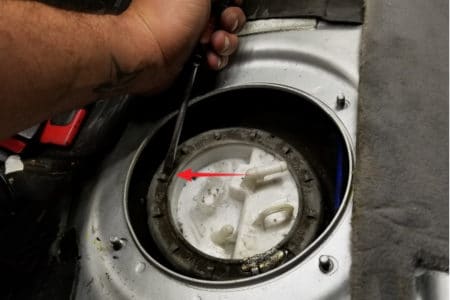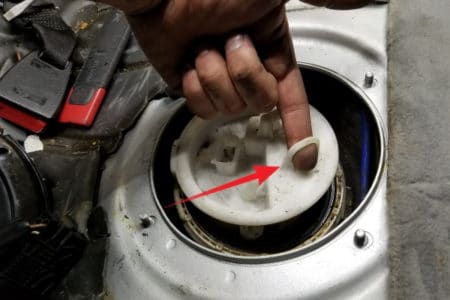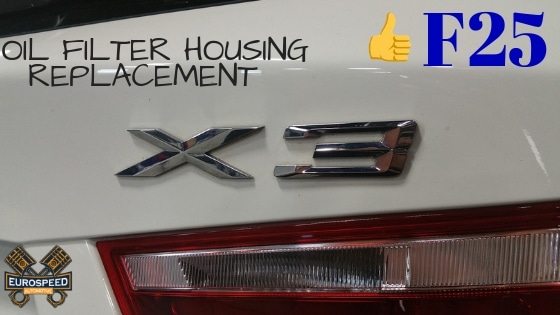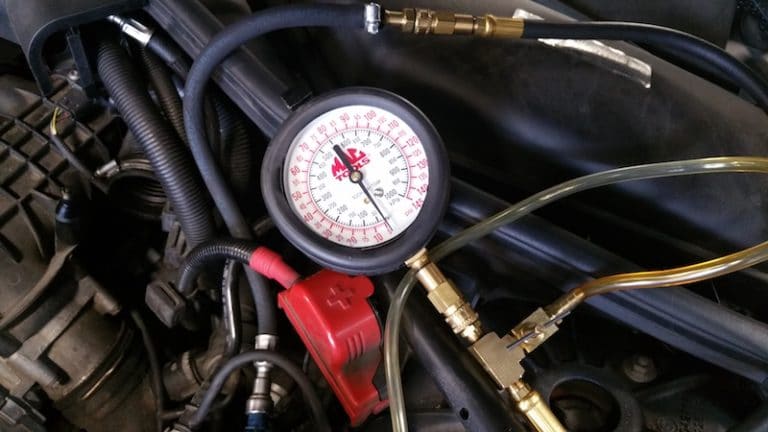Jump Ahead To:
How to properly change your BMW E46 fuel pump.
There are many reasons why a vehicle would not start but for this article, I will be explaining to you exactly what’s involved in a fuel delivery system, what are some of the symptoms of a failing fuel pump and exactly how to replace your own.
If you’re reading this post then chances are you woke up this morning, had your coffee got ready to head out of your home to go to work, got in your vehicle put the key in the ignition, heard the engine cranking but the car didn’t actually start.
Bummer right? yea we’ve all been there including me with the E46 I had for 7 years.
luckily you’ve come to the right place to find out how to replace your fuel pump and what’s involved in the process.
But first here is a list of the tools you will need to replace your pump.
[su_list icon=”icon: wrench” icon_color=”#FE8E48″]
- Flashlight
- flathead screwdriver or Phillips
- A small quarter inch ratchet
- 10 MM socket to go with the ratchet
- Hammer and a mid-size pry bar or big flat head screwdriver
[/su_list]
BMW E46 Fuel Pump System.
What exactly is involved in a fuel delivery system?
For a combustible engine to properly work you need fuel and air to be burned at a precise time inside the engine. every day we go to the gas station and we put gas in our cars and jump back in, drive off and follow along with our day.
The gas that you pump at the station actually goes into a fuel tank underneath your car and is hidden from plain sight and it goes for all vehicles on the road today. all of the components listed below make certain for the fuel to be available under the right conditions involved with the fuel supply system.
If you have any questions on your BMW m54 motor then visit this Wikipedia page I found on everything about BMW M54 and other motors.
[su_list icon=”icon: car” icon_color=”#FE8E48″]
- Fuel tank, filler neck, and gas cap
- Fuel tank pressure sensor
- Fuel pump
- Fuel filter
- Fuel delivery lines
- Fuel rail
- Fuel pressure regulator
- Fuel return line if equipped
[/su_list]
What are some of the parts involved with a fuel tank?
Most fuel tanks made by most manufacturers have advanced technology when it comes to the material of their fuel tanks compared to the ’80s or ’70s. today things have definitely changed for the better.
A lot of the vehicles today on the road have either corrosive-resistant material, steel or a polyethylene hard plastic. there are also some trucks out there with an auxiliary fuel tank to help with the demand of fuel pertaining to the vehicle.
Fuel tank design and functionality have evolved exponentially with the times. regardless of the size or what company makes it, they all incorporate most of all if not some of the features I list below.
[su_list icon=”icon: car” icon_color=”#FE8E48″]
- Filler tube or inlet where fuel travels down to tank in
- Gas cap with pressure relief and holding features
- An outlet to the fuel line leading to the fuel pump if equipped
- Fuel pump mounted within the fuel tank
- Fuel tank vent system for fuel vapors
- Fuel level sending unit and pick up tube
[/su_list]
What are some of the safety features involved in a fuel tank?
By federal and international law all vehicle manufacturers are mandated to require safety features to be added in the development of the fuel delivery and supply system to prevent loss of life. I am referring to roll over cases.
You can read more about these laws here!.
If you have ever been in a rollover accident then you know exactly what I mean.
One of the key features and innovations made is called a one-way check valve. in the image below I show you what that is.
There are multiple locations where vehicle manufacturers place this feature but for the most part, it is usually between the engine and the fuel tank. it can also be installed in the vapor vent line, fuel return line or the fuel tank filler cap.
For more added safety some vehicles have been equipped with technology that actually cuts off electrical power to the fuel pump when an accident happens.
What is an electric fuel pump?
Think about your BMW fuel pump as a pusher unit. so basically the fuel you pump sits in the gas tank and the pump itself pushes the fuel through lines going to a fuel rail which then passes through fuel injectors and they spray fuel into the cylinders of your engine.
There are a few types of styles of pumps but for the most part, the majority of them are either impeller or turbine. most vehicles use these two kinds.
All electrical pumps use a small electrical motor built inside but the turbine style is usually more quite then the others.
Some of the basic elements inside an electric fuel pump are listed below.
[su_list icon=”icon: car” icon_color=”#FE8E48″]
- Field housing for armature
- Armature
- Brush carrier assembly
- Driver and impeller
- Gerotor assembly
- Inlet and outlet plate
[/su_list]
What is a fuel filter?
For the most part, a fuel filter is exactly what it is a filter. the fuel we pump into our tanks we don’t get to see as we pump. it comes from the ground of our earth and it is refined and goes through a process before ever reaching your local gas station.
There will always be impurities and other kinds of elements from the earth so the job of the filter is to filter out all those foreign contaminants to prevent damage.
Most filters are designed to remove dirt, rust, water, and other junk in the fuel before it reaches the fuel injectors. they also filter out particles smaller than 20 microns in size.
[su_note note_color=”#FE8E48″ text_color=”#0F2940″ radius=”20″]TECH TIP – Be sure to install your fuel filter correctly. it has a flow of direction for the fuel so if installed wrong it can cause low power at higher engine speed and load.[/su_note]
How does the fuel in my tank reach my engine?
I covered just a few of the major parts involved in the fuel delivery system for your vehicles such as a tank, pump, and filter. the way the actual fuel travels from the tank and to the engine is by the means of fuel lines.
Special fuel vapor lines made of steel, nylon tubing or fuel resistant rubber are involved in the fuel delivery system and connect it all together.
The lines run from the back of the car at the gas tank from the pump. once it leaves the pump it travels through the lines underneath the vehicle.
Fuel then makes its way through the filter and passes through the fuel rail before being blasted into the engine by the fuel injectors.
Bmw E46 fuel pump failure symptoms.
From my own experience, I can honestly tell you I’ve owned a 2000 328i for 7 years with an m52(TU) engine it and it was such an amazing little beast. plus it was a 5 speed.
I believe I was the third owner of the vehicle and when I purchased it, the dashboard dialed in at 128,000 miles altogether. that car was so great on gas and hardly gave me any headaches apart from the usual maintenance items.
Seven years after I bought the car I couldn’t believe it actually made it to a whopping 198,000 miles and then the fuel pump gave out. it most likely was the second one ever installed in the car but I was still surprised it lasted that long.
There are some symptoms you can experience before your pump actually fails and leaves you stranded. some of those symptoms are listed below.
[su_list icon=”icon:car” icon_color=”#FE8E48″]
- Hard starting
- Rough idle
- Misfiring
- Hesitation and stalling
- Low power
- Sluggage behavior
- Idle surge or RPM fluctuations
[/su_list]
For every vehicle, the symptoms can vary but for my case, I did experience having hesitations under heavy load especially driving onto an onramp of a highway.
Fuel injected systems which are more relevant in today’s day and time are more sensitive than older systems from the past. fuel pressure and fuel volume play a very important role to keep your engine running as smooth as butter.
A fuel pump that works and seems as if nothing is wrong with it can demonstrate delivering the right amount of fuel pressure but not enough fuel volume and can allow the engine to run smooth and seem fine at idle.
That’s exactly what I was experiencing in my case. my pump was having enough pressure but it was not pushing the correct volume under certain conditions. (under a load)
This type of problem can easily starve the engine of fuel and cause it to have loss of power or slight hesitation under a load or hard acceleration.
What are possible causes of a dead fuel pump or (crank but no start condition)?
A dead fuel pump or one that doesn’t seem to be operating properly when you first turn the ignition switch on can point towards an electrical issue. perhaps a fuse, bad relay, or an issue with wires such as a short circuit.
A super clogged or plugged fuel filter can definitely cause a no start condition also.
Very low fuel pressure can also do it but if you have any bends or dents on the fuel lines it can definitely restrict fuel flow from the tank to the engine and can also cause a no start. so you might want to verify that it isn’t the case for you.
If the pump does work and you hear it working but still have a no start.
[su_list icon=”icon: car” icon_color=”#FE8E48″]
- Possible no voltage to fuel injectors
- Possible blown injectors
- Possible relay
- Pulse signal to injectors from DME
- Shorted fuel injector robbing voltage from other injectors
[/su_list]
How to replace your BMW E46 fuel pump.
[su_note note_color=”#FE8E48″ text_color=”#0F2940″ radius=”20″]CAUTION! DO NOT I REPEAT DO NOT REPLACE YOUR FUEL PUMP WHILE SMOKING A CIGARETTE AND KEEP ANY LIGHTERS OR MATCHES AWAY WHILE YOU HAVE THE GAS TANK OPEN. ALSO, RELEASE FUEL PRESSURE BY UNSCREWING SCHRADER VALVE ON FUEL RAIL.[/su_note]
There are many possible variables in the way of finding the actual problem with your bad fuel pump but for the most part, it’s not very difficult.
One of the very first things you should do assuming you have some “do it yourself” experience or know your way around your E46 is to actually verify if the pump is running when you turn the ignition on.
For the BMW e46 model, the fuel pump is located in the gas tank underneath the back seats. so grab the back seat and lift up very hard and you’ll be able to remove it easily.
Step 1.
Now once you have located the pump area under the seat behind the passenger side use a ten-millimeter socket on a ratchet and remove the four nuts off and the pump housing is exposed.
Now while you or someone else is sitting on the driver seat turn the ignition switch on but don’t crank it and you should hear the pump make a buzzing sound assuming its good. If it doesn’t make a little noise then the pump is not spinning or running. Most of the time the fault will be on either the control side or load side of the circuit.
If that is the case then go to the glove box and check the fuse for the fuel pump using a test light if you have one if not then look at the chart that comes with your car, locate the fuse number (54) then physically remove it and see if it’s popped.
If the fuse is good then you will have to dig a little deeper and locate the fuel pump relay and test it if that is actually working properly also but for this article lets assume the fuse and the relay is good and all the electrical aspect of the circuit is good.
Assuming you do have a bad fuel pump and not an electrical issue where we have to check for shorts and wiring issues I will be showing you what the next steps will be here.
Step 2.
After you have removed the black cover for the pump you will see the top of the pump exposed, a connector or harness and a rubber fuel line attached to the pump being tied down by a hose clamp. Remove them carefully.
Step 3.
Take your flat head screwdriver and pry in between the connector where I point to in the picture above and separate the holder and remove the connector.
Step 4.
After that, right above that unscrew the little hose clamp and pull off the fuel hose with one hand slowly and pry with the screwdriver with the other hand. use your judgment carefully. try not to rip or damage the hose.
Almost there!
Now that the connector and hose are completely off you can move those things aside and move forward.
Step 5.
Take your pry bar or big flat head screwdriver and place it on one of the ridges on the metal ring and use the hammer and tap the ring off hitting it counterclockwise until it loosens off.
You should be able to slowly remove the ring off after you whack it a few times but for the most part it should be easy going.sometimes they do get stubborn but that’s if it has never been removed or accumulated rust.
I do have the actual special tool to remove the pump but when I was taking these pictures one of my friends borrowed it for the weekend a few days prior so I had to use the old school way and use a pry bar.
If you have the special tool then use it but if you’re doing this job in your garage at home then its cool.
Step 6.
Once you hacked the metal ring holder to death then slowly pull up towards the roof of the car and remove the fuel pump like I show you in the picture below and carefully try not to spill any fuel in your carpet because that stuff will stick and it will linger for a while.
Use rags or old shirts to catch any fuel and keep a pan or something you can place it to let all the fuel to drain out of it.
And you are done!
After that then all you have to do is install the new unit in reverse order than flip the ignition switch a few time on and off to prime the pump that way there is enough fuel at the motor to have an easy startup and not have a bad misfire.
Do not forget to replace the o-ring that comes with your new fuel pump. and install the o-ring first onto the fuel tank.it will make life easier.
Let the vehicle run for about 10 mins and let the system get back to normal clear any faults with a scanner that have been registered in the DME and take your sweet ride for a well-deserved test drive!
If you enjoy this type of content please share on your social media platforms and forums. any type of exposure to my content will be greatly appreciated. I enjoy teaching and helping others with their problems related to German cars.
Also if you guys like what you read and want me to write more of these how to type articles, comment below. If you have any specific jobs you want me to tackle then I will write a blog post on it.
If you have any questions about this repair or any other questions regarding anything BMW then feel free to comment down below and I will personally get back to you and answer any questions to the best of my knowledge.
If you haven’t yet please subscribe to my newsletter here to stay up to date on a weekly post on subjects like diagnosing, repair, industry news and much much more.
If you are in the Tampa Bay area and would like to schedule an appointment with me if you are having issues with your car then schedule an appointment with me today.
Thank you for reading and happy motoring!

